91+ Real-World Diversity in the Workplace Statistics
Since everyone has to make a living, the most appropriate place to educate individuals about diversity is in the workplace. Here are more than 91 statistics about diversity in the workplace.

There are so many minority groups in the United States that deal with double standards and discrimination. But you already knew that, especially given the current political climate.
Unfortunately, though, the hardships that these minority groups that I’m referring to go through sometimes bleeds into the workplace.
Some of the barriers in the hiring process that occur happen due to individuals…
- Ethnicity
- Gender
- Race
- Age
Although state and federal governments have laws in place that address the illegality of discrimination, it still happens.
One effective way to combat discrimination, though, is through education on diversity. Since everyone has to make a living, the most appropriate place to educate individuals about diversity is in the workplace.
Here are more than 91 statistics about diversity in the workplace.
Population Statistics
The workplace is only a portion of the total population in the United States. Therefore, to understand racial and gender diversity in the workplace, we must first take a look at what is going on in the U.S. as a whole.
Not only that, but generations have different levels of diversity as well. This might be because of different levels of immigration over the years. It could also be because as time goes on, more and more of the youth take pride in their cultural heritage and identify with more minorities.
Either way, here are some facts to give you a better understanding of the current demographic climate…
- Less than 58% of the U.S population identifies as white or non-Hispanic in 2020 (AP News)
- In contrast, the number used to be 63.7% in 2010
- Projected growth among traditionally underrepresented populations means that by 2044, many minorities will hit majority status (SHRM)
- White, non-Hispanic, individuals make up 57.8% of the U.S. population (Census Bureau)
- Hawaii had a Diversity Index of 76% in 2020, the highest of any state (Census Bureau)
- The Hispanic or Latino population consists of 18.7% of the U.S. population, the second-largest racial or ethnic group in the country (Census Bureau)

General Workforce Statistics
Before we get deeper into the different groups that make up a diverse place of employment, we need to also understand what the general workforce looks like in the United States.
At this point, it’s common knowledge that people of European descent make up the majority of the active workforce. In recent years, news outlets have highlighted job and pay disparities between African Americans and their white counterparts. The media has also highlighted wage discrepancies and differences in treatment for women compared to men.
Unless you identify as a specific type of minority, chances are you don’t know much about other people’s experiences in the workplace. Here are a handful of statistics that give insight into the current workforce of the U.S…
- Whites made up 78% of the workforce in 2019 (BLS Reports)
- African Americans or Blacks made up 13% of the workforce
- Asians made up 6% of the workforce
- Indigenous Peoples and First Nations made up about 1%of the labor force
- Less than 1% of the workforce consists of Native Hawaiians and other Pacific Islanders
- People of two or more races made up 2% of the labor force
- 17 percent of the U.S. workforce is foreign-born (Bureau of Labor Statistics)
- 66.6% for people of two or more races
- 66.3% of Hispanics participate in the US workforce
- 63.5% of Asians in the US participate in the labor force
- 62.8% of Whites participate in the US workforce
- 59.6% for Indigenous Peoples and First Nations
- 76% of job seekers consider a diverse workforce is important during job offer considerations. (Glass Door)
- One-third of employees wouldn’t apply to a job at a company where there is a lack of diversity among its workforce. (Glass Door)
- 18.3% of all businesses in the U.S. are minority-owned (United States Census Bureau)
- Based on current trends, it will take almost 70 years for minority-owned businesses to achieve statistical parity in paid employment. (Minority Business Development Agency)
- It’s less likely that a minority-owned firm will receive loans than non-minority owned firms. (Minority Business Development Agency)
- 87% of companies said they were “highly committed” to gender diversity in 2021 (McKinsey)
- 65% of Black employees feel that they have to work harder to advance (Coqual)
- It’s projected that in 20 year “minority” groups will hit majority status (SHRM)
Age in The Workforce
As time goes on, the demographic of people working changes.
There’s a constant cycle of older generations aging and retiring.
For example, Baby Boomers are currently between the ages of 76 and 57. This means that a good number of them have already retired or are looking to retire within the next 10 years.
New generations enter the workforce and start to earn a name for themselves. CNN lists Generation Z as individuals born between 2000 and the present day. This means that the oldest Generation Z individuals are 22 years old. They’re just beginning to graduate from high school and college and enter the workforce.

When it comes to age, this is what the workforce looks like today…
- 72% of Baby Boomers are white (CNN)
- 56% of Millenials are white
- 48% of Generation Z represent racial minorities or ethnic minorities in 2018 (Pew Research Center)
- 39% of Millenials identified as a minority in 2002
- 30% of Generation X identified as a minority in 1986
- 18% of Boomers in 1968 identified as a minority
- 25% of Generation Z identified as Hispanic in 2018 (Pew Research Center)
- Compared to baby boomers, Millennials are 16% more diverse (CNN)
- The number of employees over the age of 75 will increase by 96.5% within the next ten years (U.S. Bureau of Labor Statistics)
- The amount of workers between the ages of 16 to 24 is projected to shrink by 7.5% within the same period
- The employment rate of the workforce of 55 years and older decreased to 36% in 2020. (Statista)
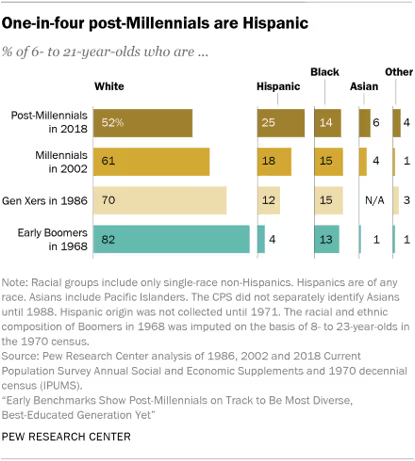
Benefits of Diversity
Are there benefits to diversity?
The statistics below indicate that yes, there are. Having a wide variety of backgrounds on your team can increase productivity, profits, and revenues.
From outperforming the competition to increasing innovative breakthroughs, having talent from many backgrounds means that your organization has a better chance of succeeding. That statement is especially true when you make the comparison between diverse and monolithic teams.

- Gender-diverse companies are 15%more likely to beat average industry financial returns (Mckinsey & Company)
- Diverse teams see 2.3 times the cash flows per employee compared to less diverse or more monolithic teams (Cision)
- Companies with above-average diversity reported innovation revenue that was 19% higher than companies with below-average leadership diversity (BCG)
- It's said that businesses in the top quartile for staff diversity perform 35% better than companies who only match the national average (McKinsey)
- Diverse companies are 25% more likely to have above-average profitability (McKinsey)
- There is a greater chance for outperformance among employees in organizations that have more diversity (LA Times)
- Companies with diverse staff are 70% more likely to capture new markets (Harvard Business Review)
- Organizations who are gender-diverse are 15% more likely to beat industry median financial returns (McKinsey)
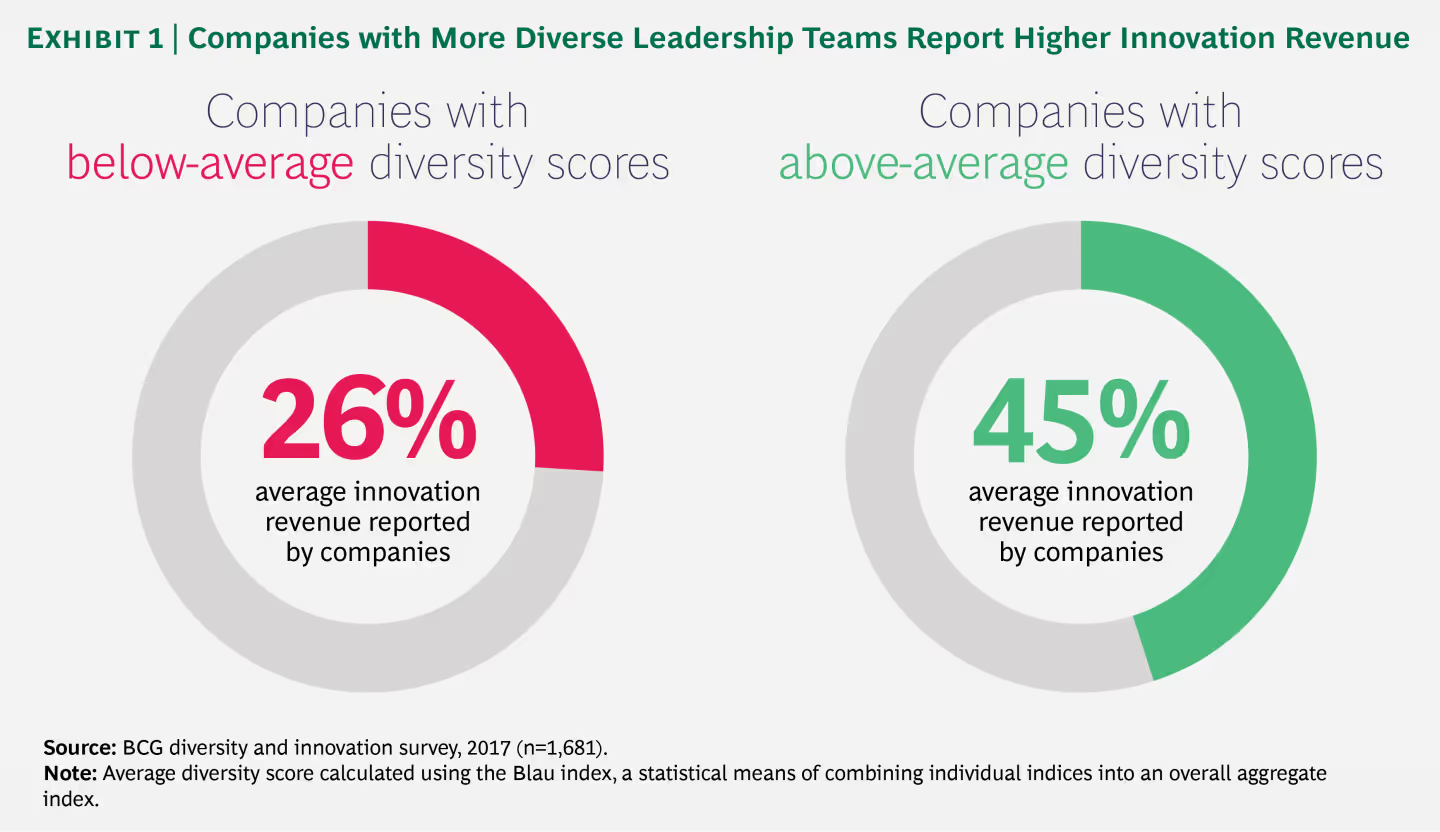
Women in The Workforce
Most people have heard that women get paid less than men on average for completing comparable duties and comparable companies.
But women in the workforce don’t just face pay discrimination. They also face microaggressions and often get overlooked during promotions.
Yet women in leadership positions can do a world of good for the company’s bottom line. They also often tend to promote diversity initiatives more than men, according to the statistics you’re about to read.
Below are some statistics about how women affect their work environment and what they endure in the workforce.
- Estimations state that women will make up 47.2% of the workforce by 2024 (Deloitte)
- A survey found that 42% of women in the U.S. say they have faced workplace gender discrimination (Pew Research Center)
- 25% of women say they earned less than a man doing the same job
- 23% say they felt treated as though they were not competent in the workplace due to their gender
- 10% say they felt overlooked for the most important assignments
- 71.2% of White mothers, 65% of Asian mothers, and 63.9% of Hispanic mothers also participate in the U.S. workforce
- 8.1% of Fortune 500 CEOs are women (Fortune)
- This equates to 4` female chief executives
- Two of the women are African American or Black
- 25% of C-Suite executives are women (Korn Ferry)
- Of those, 4% are women of color
- 45% of employed White women, 36% of employed Black women, and 27% of employed Hispanic women work in similar positions (Bureau of Labor Statistics)
- 86 women get promoted to manager for every 100 men given the same promotion (McKinsey)
- Women receive raises 5% less often than men despite asking for a wage increase at the same rate as men (Harvard Business Review)
- In 2018, women earned more than half of all bachelor’s degrees (National Center for Education Statistics)
- Over 150 white women and people of color have been appointed CEOs at Fortune 500 companies since 2000. (University of Southern California Santa Cruz)
- Almost twice as many women joined the workforce than men in 2021 (The 19th)
- 55% of the workforce was female in 2018 (Chron)
- Of the 2.1 million women who left the workforce in 2020, 22% were Black mothers, 20% were Asian mothers and 19% were Hispanic mothers (WerkLabs)
- 20% of all firms in the U.S. are owned by women (Census)
- Women owned businesses make up 25% of all businesses in the state of Hawaii (Census)
- Women earned 84% of what men did in 2020. (PewResearch)
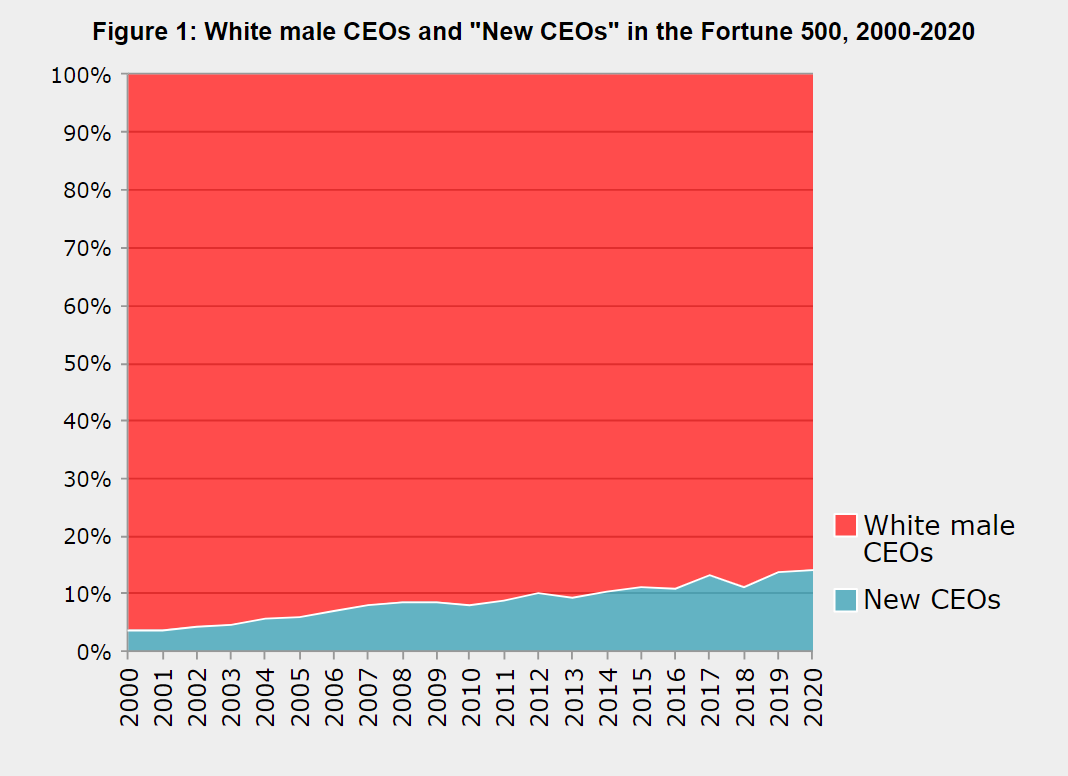
LGBTQ+ in The Workforce
As time goes on, gender diversity becomes more and more prevalent in the workplace. An increasing number of companies across the country recognize the LGBTQ+ community.
As such, it is important to discuss the LGBTQ+ experience in the workplace when discussing diversity. Below are some statistics regarding their experience.
- 19.1% of heterosexual married-couple families live on an income provided solely by the husband (Bureau of Labor Statistics)
- 7.6% of the same type of heterosexual households live on an income provided solely by the wife
- 46% of LGBTQ+ employees are closeted at work (HRC)
- Transgender people are more likely to view their gender or orientation as a barrier towards advancement (McKinsey)
- LGBTQ+ people make up 6% of all employees (Williams Institute)
- 59% of non-LGBTQ+ workers agree that it’s unprofessional to talk about sexual orientation and gender identity in the workplace (HRC)
- In June 2020 the U.S. Supreme Court ruled that employment discrimination based on sexual orientation or gender identity is illegal under Title VII of the federal Civil Rights Act (MAP)
- Of LGBTQ+ adults who face discrimination, three in five of them are transgender on average (Center for American Progress)
- 67% of Fortune 500 Companies provide trans-inclusive health insurance (HRC)
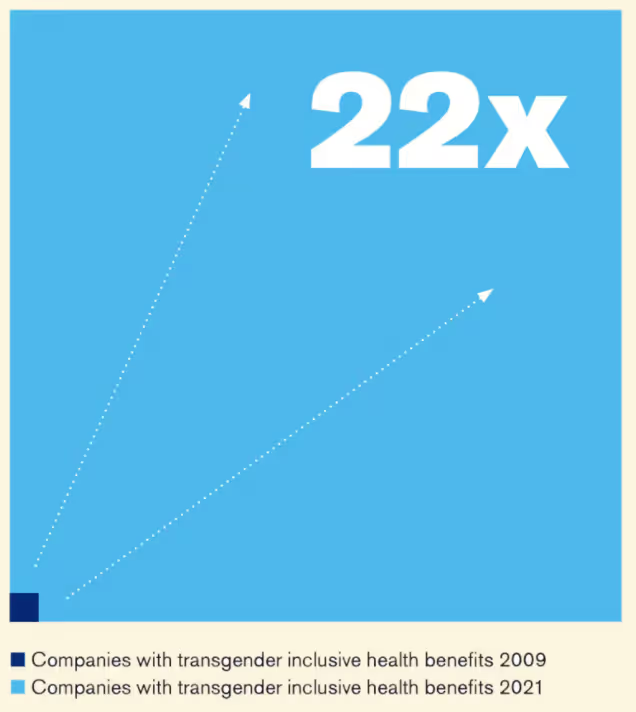
Employment Statistics
When it comes to the workforce, there are two main categories: those who are currently employed and those who are actively seeking employment.
Those who are actively seeking employment count in unemployment statistics. If someone is not actively seeking a job, they’re not part of the unemployment statistics.
Let’s first look at those people who currently have jobs. Different ethnicities face different hurdles in the workforce. Some face pay gaps due to their ethnicity while others don’t get called back to more interviews because of the way their name sounds.
It’s important to look at the current situation minorities face at work.

- 17.9% of people with a disability had a job in 2020 (Bureau of Labor Statistics)
- This is down from 19.3% in 2019
- The unemployment rate for Black and Latinx people is higher than other ethnic groups (Brookings)
- There are 5 CEOs of Fortune 500 companies that are Black (NPR)
- “Distinctively black names” are less likely to hear back from job applications (NBER)
- 200 of the Fortune 500 companies have a board reflecting 40% diversity (Cooley)
- 77% of the workforce in 2020 were white people (Bureau of Labor Statistics)
Unemployment Statistics
To reiterate what I said above, unemployment statistics involve people who are actively looking for work when they’re not currently employed. If someone’s not actively looking for work and isn’t currently employed, then they aren’t included in the unemployment statistics.
With that said, diversity in the unemployed world is just as important to understand as the diversity in the employed world.
- Unemployment rates for veteran men increased to 6.5% in 2020 (Bureau of Labor Statistics)
- At the same time, unemployment for women veterans increased to 6.7%
- Unemployment for disabled individuals reached 7.9% in 2020 (Bureau of Labor Statistics)
- African Americans or Blacks endured an unemployment rate of 6.1% in 2019 (BLS Reports)
- The National Average was 3.7%
- Indigenous individuals faced unemployment at a rate of 6.1%
- People of two or more races faced unemployed at a rate of 5.3%
- The unemployment rate of foreign-born workers rose to 9.2% in 2020 (Bureau of Labor Statistics)
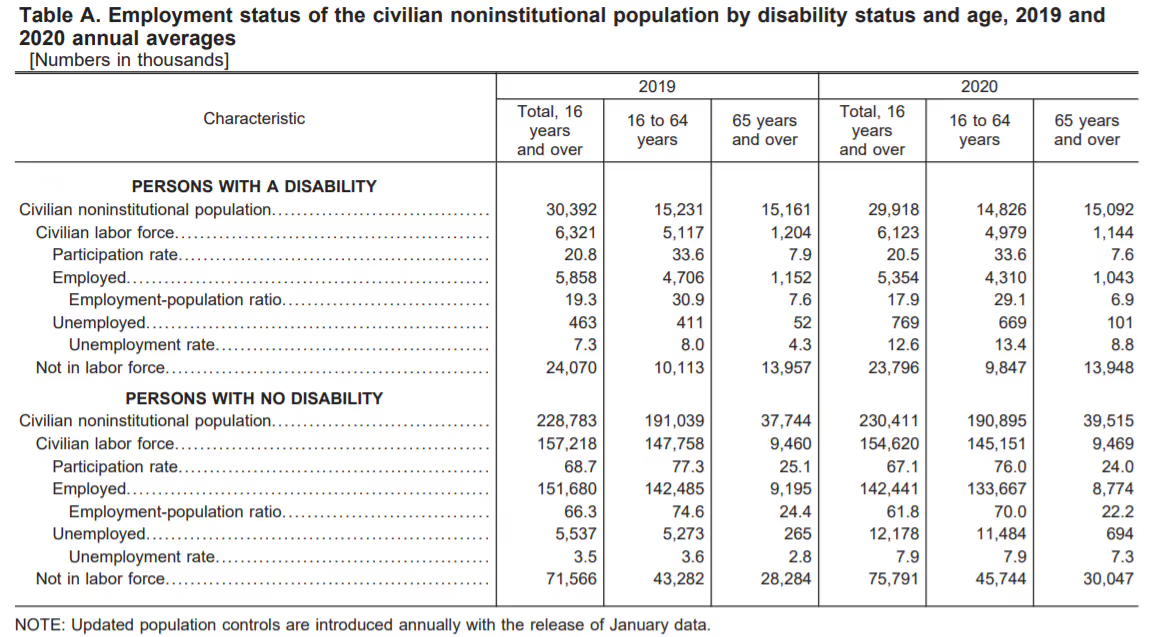
Conclusion
As you can see, there are many ways people face discrimination in the professional world. Whether currently employed or remain unemployed, minorities across the country face double standards and discrimination.
There are double standards for gender minorities. Many know that women earn less than men for working the same type of job at similar companies. But women face other double standards as well.
And it's not just women. Members of the LGBTQ+ community also face discrimination due to their gender identity or sexual orientation. Some are so concerned about discrimination that they are certain their identity will negatively impact their career opportunities.
Racial or ethnic minorities also face hardships when maintaining a job or trying to obtain a job. From interview callbacks to discrimination in the workplace, there are many obstacles to overcome. African American or Black individuals face many of these obstacles. Hispanic, Indigenous, Hawaiian, and other racial minorities face similar hardships
Emphasize your product's unique features or benefits to differentiate it from competitors
In nec dictum adipiscing pharetra enim etiam scelerisque dolor purus ipsum egestas cursus vulputate arcu egestas ut eu sed mollis consectetur mattis pharetra curabitur et maecenas in mattis fames consectetur ipsum quis risus mauris aliquam ornare nisl purus at ipsum nulla accumsan consectetur vestibulum suspendisse aliquam condimentum scelerisque lacinia pellentesque vestibulum condimentum turpis ligula pharetra dictum sapien facilisis sapien at sagittis et cursus congue.
- Pharetra curabitur et maecenas in mattis fames consectetur ipsum quis risus.
- Justo urna nisi auctor consequat consectetur dolor lectus blandit.
- Eget egestas volutpat lacinia vestibulum vitae mattis hendrerit.
- Ornare elit odio tellus orci bibendum dictum id sem congue enim amet diam.
Incorporate statistics or specific numbers to highlight the effectiveness or popularity of your offering
Convallis pellentesque ullamcorper sapien sed tristique fermentum proin amet quam tincidunt feugiat vitae neque quisque odio ut pellentesque ac mauris eget lectus. Pretium arcu turpis lacus sapien sit at eu sapien duis magna nunc nibh nam non ut nibh ultrices ultrices elementum egestas enim nisl sed cursus pellentesque sit dignissim enim euismod sit et convallis sed pelis viverra quam at nisl sit pharetra enim nisl nec vestibulum posuere in volutpat sed blandit neque risus.

Use time-sensitive language to encourage immediate action, such as "Limited Time Offer
Feugiat vitae neque quisque odio ut pellentesque ac mauris eget lectus. Pretium arcu turpis lacus sapien sit at eu sapien duis magna nunc nibh nam non ut nibh ultrices ultrices elementum egestas enim nisl sed cursus pellentesque sit dignissim enim euismod sit et convallis sed pelis viverra quam at nisl sit pharetra enim nisl nec vestibulum posuere in volutpat sed blandit neque risus.
- Pharetra curabitur et maecenas in mattis fames consectetur ipsum quis risus.
- Justo urna nisi auctor consequat consectetur dolor lectus blandit.
- Eget egestas volutpat lacinia vestibulum vitae mattis hendrerit.
- Ornare elit odio tellus orci bibendum dictum id sem congue enim amet diam.
Address customer pain points directly by showing how your product solves their problems
Feugiat vitae neque quisque odio ut pellentesque ac mauris eget lectus. Pretium arcu turpis lacus sapien sit at eu sapien duis magna nunc nibh nam non ut nibh ultrices ultrices elementum egestas enim nisl sed cursus pellentesque sit dignissim enim euismod sit et convallis sed pelis viverra quam at nisl sit pharetra enim nisl nec vestibulum posuere in volutpat sed blandit neque risus.
Vel etiam vel amet aenean eget in habitasse nunc duis tellus sem turpis risus aliquam ac volutpat tellus eu faucibus ullamcorper.
Tailor titles to your ideal customer segment using phrases like "Designed for Busy Professionals
Sed pretium id nibh id sit felis vitae volutpat volutpat adipiscing at sodales neque lectus mi phasellus commodo at elit suspendisse ornare faucibus lectus purus viverra in nec aliquet commodo et sed sed nisi tempor mi pellentesque arcu viverra pretium duis enim vulputate dignissim etiam ultrices vitae neque urna proin nibh diam turpis augue lacus.




